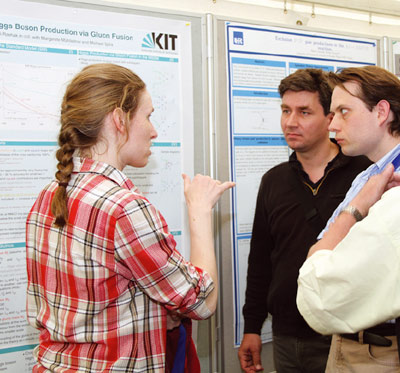
“Physics at the LHC 2010”, which took place at DESY in Hamburg on 7–12 June, was the first large conference to discuss 7 TeV collision data from the LHC. Covering all fields of LHC physics, it attracted 270 participants, among them many young postdocs and students.
On the opening day, Steve Myers, CERN’s director for accelerators and technology, gave an overview of the LHC’s status and the steps required to increase the luminosity. The spokespersons of the four big experiments, Fabiola Gianotti (ATLAS), Guido Tonelli (CMS), Jurgen Schukraft (ALICE) and Andrzej Golutvin (LHCb) summarized the commissioning of their experiments and the progress in understanding the detectors, and also flashed up the first physics results.
The main message from these presentations was that the LHC is progressing well and that the experiments are well prepared. Data-taking is going smoothly, triggers and reconstruction are working well and detectors are rapidly being understood. Data processing on the LHC Computing Grid is also performing as expected.
There was special emphasis at the conference on the operation and performance of detectors and in the afternoon sessions young researchers reported on experiences in all of the experiments. The reports showed that many design performances have already been achieved or are within close reach. One by-product of understanding the detectors is a “detector tomography”, which has been performed using mainly photon conversions; this has allowed several shortcomings of the detector simulations to be identified and removed.
The pay-off for the years of hard work that led to this excellent knowledge of the detectors has been a quick turnaround time for physics results. After only a few weeks of high-energy data-taking at 7 TeV in the centre-of-mass with an integrated luminosity of about 16 nb–1 delivered to each experiment, all four collaborations have rediscovered almost the full Standard Model particle spectrum – except for the top quark, which is just round the corner.

Among the first LHC physics highlights are the observations of W and Z bosons, and of high-pT jets. In several presentations the audience was reminded of how long the community waited for single weak bosons to be produced in the early days of the SppS. Now, dozens of W and Z bosons have already been reported by ATLAS and CMS in different decay channels. However, there is still a long way to go to match the excellent work done in the electroweak sector by the experiments at Fermilab’s Tevatron.
The political support for the LHC in Germany was touched upon on the third day of the conference. In their messages, Georg Schütte, state secretary in the German Ministry for Education and Research, and Bernd Reinert, state secretary for science and research of the state of Hamburg, expressed the keen interest of the funding bodies for further support and exploitation of the LHC.
Looking at the prospects from the scientific point of view, Mike Lamont of CERN sketched the plans for the LHC and emphasized the goal of collecting 1 fb–1 proton-collision data per experiment at 7 TeV before the end of 2011 (plus two heavy-ion runs). With this integrated luminosity, the LHC will already compete with the Tevatron in a number of fields. It would be sensitive to W’ and Z’ bosons with masses up to 1.9 TeV and 1.5 TeV, respectively, and low-mass supersymmetry would also be in reach. However, the Higgs – if this is indeed nature’s choice – will most likely take longer to be discovered.
The last day of the conference was dedicated to overview talks from other fields (astroparticle physics, dark-matter physics) and concluded with an excellent experimental summary by CERN’s Peter Jenni and a visionary overview of theory by David Gross, the 2004 Nobel laureate in physics. Gross reflected on 20 predictions made in 1993 – a good fraction of which have already come true. There is reason to hope that at least a few others (among them the discoveries of the Higgs, supersymmetry and the origin of dark matter, and the transformation of string theory into a real predictive theory) will also come true. There are exciting times ahead.





